Its [It’s] Q: The Winged Serpent on Blu-ray!
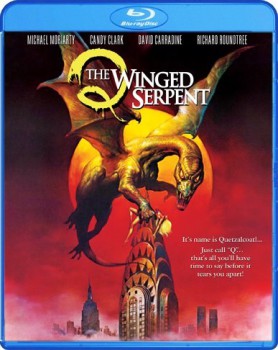 Q (1982)
Q (1982)
Written, Produced, and Directed by Larry Cohen. Starring Michael Moriarty, David Carradine, Candy Clark, Richard Roundtree.
You want to know something that rocks? Actually, two things that rock, at least in my little world:
1. The Chrysler Building
2. Giant Monsters
So when you have a movie about a giant flying monster nesting in the Chrysler Building, you have something that rocks so hard it makes Van Halen sound like One Direction. Again, at least in my little world.
Video distributor Shout! Factory continued its stellar series of classic B-movie releases on Blu-ray in September with the HD debut of Q. This 1982 sleeper hit, concerning the Aztec god Quetzalcoatl (or a non-god of the same name) appearing in New York City as a humungous flying snake that likes to snap the heads off window washers and topless sunbathers, was always crying out for Shout! Factory to pluck it up.
The company has packaged the film with its alternate marketing title, Q: The Winged Serpent, and repeated the original tagline over the Boris Vallejo artwork: “It’s name is Quetzalcoatl… Just call it ‘Q’… that’s all you’ll have time to say before it tears you apart!” However, Shout! Factory fixed the original poster’s grammatical error, correcting It’s to Its. That is one of the few disappointments I have with their presentation of this nifty low budget flick; I know Shout! Factory doesn’t want to seem careless on the cover for their product, but that grammatical glitch adds charm to the story of a clueless low-life criminal/jazz pianist who holds New York hostage with a winged snake.
The 1980s was an arid time for the giant monster flick. The 1950s and ‘60s were the golden age for the great entertainment of watching towering beasties causing urban mayhem. Even the ‘70s had some spillover with the last run of the classic Godzilla movies and the ambitious, if not-that-great, Dino DeLaurentiis re-make of King Kong. The ‘80s only had two Godzilla films (one of which didn’t make it stateside until the ‘90s), a horrible sequel to the DeLaurentiis’s Kong, and not much else. Q is easily the decade’s best giant monster movie, even though the monster has limited screen time.
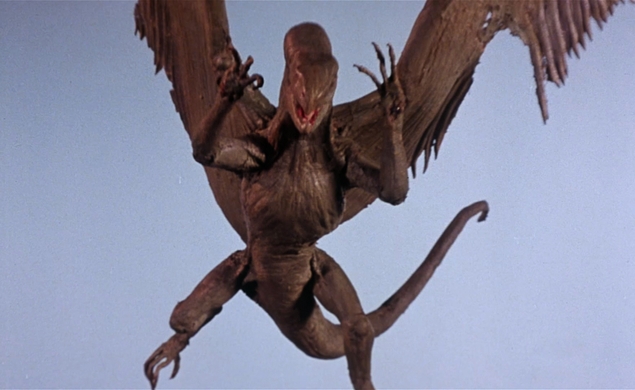 Larry Cohen, one of the most energetic exploitation directors of the ‘70s and ‘80s (It’s Alive!, God Told Me To, The Stuff), mounted Q as a gritty cop drama with a hangover from the 1970s. It’s like Serpico and The French Connection chugged mixers of Billy Beer and Tab, woke up in 1982, and tried to get back to work. And that’s all fine with me, since it gives the monster elements of the movie an interesting setting far removed from the world of lab coats and military officers we associate with this genre.
Larry Cohen, one of the most energetic exploitation directors of the ‘70s and ‘80s (It’s Alive!, God Told Me To, The Stuff), mounted Q as a gritty cop drama with a hangover from the 1970s. It’s like Serpico and The French Connection chugged mixers of Billy Beer and Tab, woke up in 1982, and tried to get back to work. And that’s all fine with me, since it gives the monster elements of the movie an interesting setting far removed from the world of lab coats and military officers we associate with this genre.
But Q leans hard on its central performance, even more than on its monster and gruff cop heroes (David Carradine and Richard Roundtree). The monster is fantastic, and its short moments of screen time are rendered with gloriously old-fashioned VFX. But without actor Michael Moriarty and his bizarre performance as criminal loser and twitchy coward Jimmy Quinn, Q would be a hard road to trudge between winged attacks.
It’s [Its] not quite fair to say that Michael Moriarty steals the movie. After all, the title character is a flying monster, achieved through stop-motion animation done by Dave Allen and Randy Cook. It’s [Its] more a case of director Larry Cohen politely handing over large sections of the movie for Moriarty to own with his crazy, off-kilter work.
Although Q begins as it should — an unseen monster committing a bloody killing, followed by the cops arriving at the scene — it gets to core of the story right afterwards, with Jimmy Quinn in a diner with a group of other crooks planning a diamond store heist. (Quentin Tarantino took some cues from this for the opening of Reservoir Dogs.) Moriarty immediately seizes control, even though the character is out of his depth. Quinn is a nervous wreck and a terrible crook, but he blusters and motor-mouths his way through the plotting. He tries a few scenes later to take the straight and narrow when he auditions for a piano-player job at the bar where his girlfriend Joan (Candy Clark) works. Moriarty is a successful jazz musician in real life, so Jimmy Quinn’s performance is a delight in this scene. Normally, a sequence like this so early in a movie would halt it in its tracks; with Moriarty at the keys, it’s one of the most memorable in the film, and does the job of making the audience sympathize with a man who will spend a large chunk of the rest of the movie actively trying to squash all sympathy.
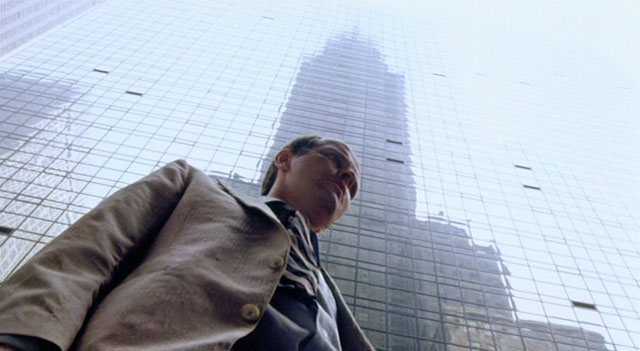 Quinn doesn’t get the piano man job, of course… so it’s back to the diamond hold-up, which ends in the poor schlub running out of the crime scene with a suitcase full of jewels, getting struck by a car, losing the loot, and then trying to dodge police pursuit. Eventually, Quinn gets all the way to the interior of the spire of the Chrysler Building to find safety. (“I’m almost afraid of everything… but I never been afraid of heights.”) And yes, all these scenes were shot inside the actual skyscraper, a thousand feet above the pavement and one slip away from turning into a red splotch on Lexington Avenue. B-movie makers: they don’t have much money, but they sure have plenty of guts.
Quinn doesn’t get the piano man job, of course… so it’s back to the diamond hold-up, which ends in the poor schlub running out of the crime scene with a suitcase full of jewels, getting struck by a car, losing the loot, and then trying to dodge police pursuit. Eventually, Quinn gets all the way to the interior of the spire of the Chrysler Building to find safety. (“I’m almost afraid of everything… but I never been afraid of heights.”) And yes, all these scenes were shot inside the actual skyscraper, a thousand feet above the pavement and one slip away from turning into a red splotch on Lexington Avenue. B-movie makers: they don’t have much money, but they sure have plenty of guts.
Inside the gleaming semi-circles of the Chrysler Building, Quinn discovers the nest and the huge egg of the creature that has recently caused blood and body parts to tumble from the Manhattan sky. And abruptly, Quinn becomes somebody “important.” First, he uses the nest to get rid of his angry bosses from the heist, and then he ransoms his knowledge to the city after it becomes aware of the killer in its skies.
Although Moriarty gives a fantastic performance throughout Q, working superbly opposite Candy Clark, it’s [its] when he starts negotiating with the NYPD and the city government that he really shines. Outside of the monster attacks, the best scene in the movie has Quinn in the mayor’s office, strutting his newfound power. How much of the bluster Quinn truly believes as he lays out his ridiculous demands is difficult to say, and that’s to Moriarty’s credit. This scene is also David Carradine’s best moment in Q, as he tries to feel out what the hell is going on in the mind of this twitchy weirdo.
Unfortunately for David Carradine (and Richard Roundtree), most of his scenes are in the, uhm, less gripping segments of the movie: the police investigations. As Detective Shepard, Carradine has only a minor character arc to follow: he wants to prove to his superiors that the cases of ritualized murder/sacrifice are Aztec ceremonies connected to the rooftop kills. As drama, this is weak even in the cop-movie mold, because it has no effect on the outcome of the story; whether or not Shepard can make his boss believe the link between the sets of murders, the NYPD remains on both cases and would still go after the monster. It is clear from these scenes that Jimmy Quinn is the story catalyst and the true protagonist, not Shephard or any of the police officers.
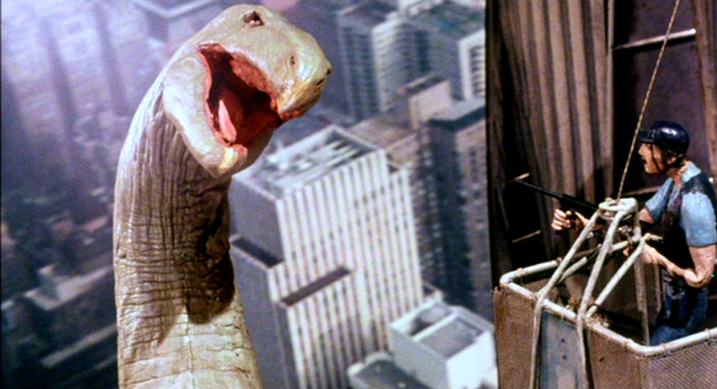 Shepard spends time talking with a few experts on Mesoamerican mythology, and in a movie more interested in eeriness and mystery, these may have been intriguing moments. But Q is a film standing in broad daylight with a huge winged monster and a screwball criminal “hero,” so there isn’t much energy or purpose to these mythology scenes. The ritual murders, with skinned victims and hearts getting torn out, lurk around the edges of the movie to provide occasional gruesomeness and give the police something to do, but they start to feel like little more than bridging material between Moriarty’s scenes and the bird-bloodletting.
Shepard spends time talking with a few experts on Mesoamerican mythology, and in a movie more interested in eeriness and mystery, these may have been intriguing moments. But Q is a film standing in broad daylight with a huge winged monster and a screwball criminal “hero,” so there isn’t much energy or purpose to these mythology scenes. The ritual murders, with skinned victims and hearts getting torn out, lurk around the edges of the movie to provide occasional gruesomeness and give the police something to do, but they start to feel like little more than bridging material between Moriarty’s scenes and the bird-bloodletting.
Worse, these scenes sometimes turn flat-out boring. When the cops move in on a suspect in the ritual murders, it’s a time-killer that arrives at the exact wrong point as the action moves toward the confrontation with the beast. Quetzalcoatl makes an abrupt appearance at the conclusion of this overlong sequence, reminding audiences of what they really wanted to see all along.
But in the middle of this bland pursuit, Richard Roundtree delivers a line loaded with unintentional irony: “Who the hell is gonna believe a ritual, sacrificial murder in 1982?” Sorry, Richard — far too many people. The Satanic Ritual Abuse moral panic of the decade was about to go over the top.
Oh hey… monster. I should talk a bit about ol’ Quetzal, shouldn’t I? Either a god or a cryptid mistaken for a god (the movie never takes a hardline stance, but gods usually aren’t susceptible to bullets), Q is a fun North American kaiju despite its scant few full-body appearances. Flying POV shots stand in for Q during much of the running time, with an occasional eerie shadow cast across buildings, courtesy of effects artist Peter Kuran.
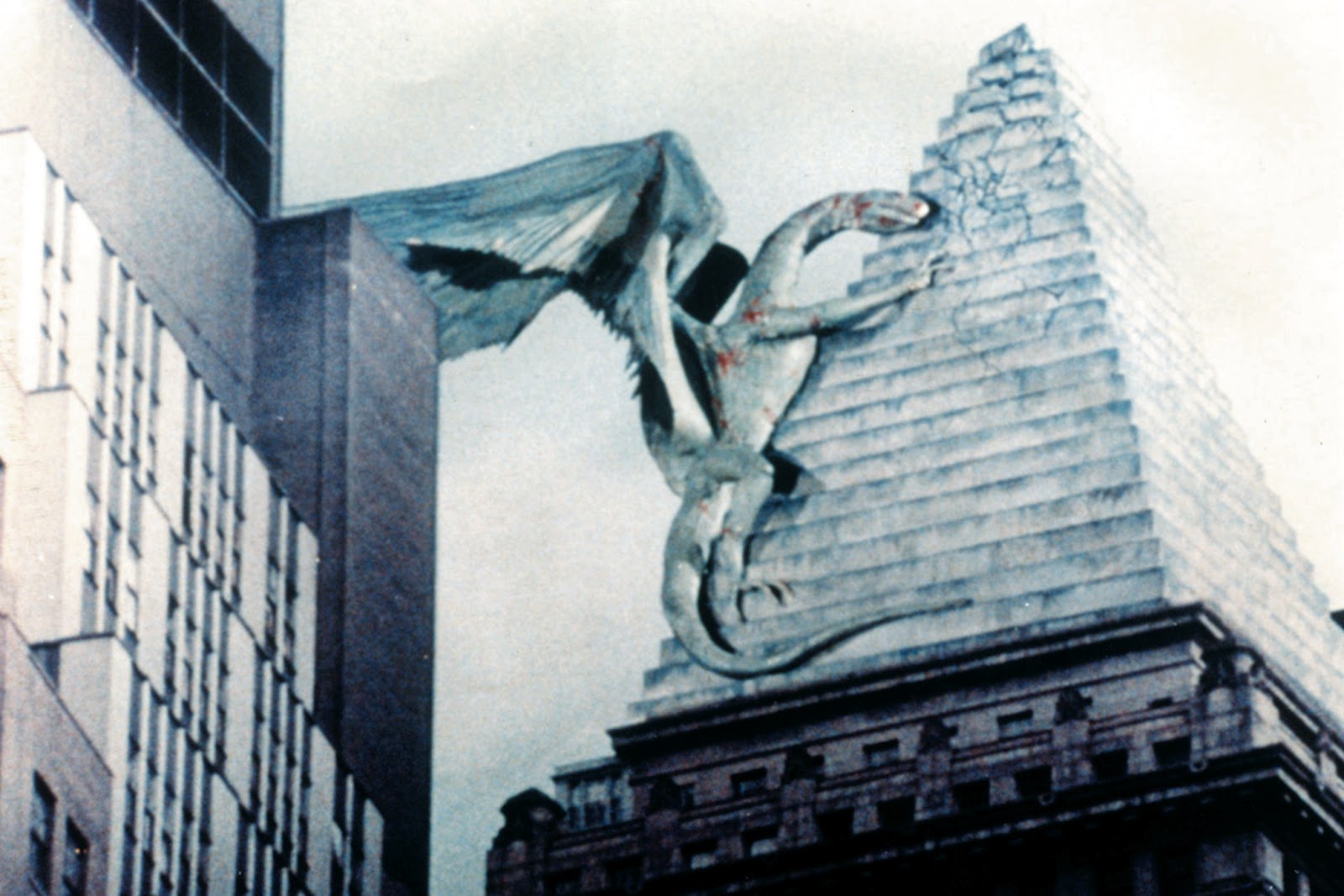 But the movie does not disappoint at the climax and offers up as much monster mayhem as it can afford. The finale is a reverse of King Kong: the monster does fly-bys at the top of a skyscraper, while the humans blaze away with automatic weaponry from stationary positions on the dome. It’s a glory of handmade special effects, with wonderful animation work Allen and Cook. A few shots have obvious mattes, and the stop-motion puppets used for the occasional humans clamped into Q’s jaws aren’t the most convincing, but it hardly matter: it’s the NYPD firing machine guns at a giant flying snake atop of arguably the most beautiful art deco structure ever raised. Hang this in the Metropolitan Museum of Art: Mesoamerican Art Wing.
But the movie does not disappoint at the climax and offers up as much monster mayhem as it can afford. The finale is a reverse of King Kong: the monster does fly-bys at the top of a skyscraper, while the humans blaze away with automatic weaponry from stationary positions on the dome. It’s a glory of handmade special effects, with wonderful animation work Allen and Cook. A few shots have obvious mattes, and the stop-motion puppets used for the occasional humans clamped into Q’s jaws aren’t the most convincing, but it hardly matter: it’s the NYPD firing machine guns at a giant flying snake atop of arguably the most beautiful art deco structure ever raised. Hang this in the Metropolitan Museum of Art: Mesoamerican Art Wing.
Detective Shepard sums it up in the film’s last line: “Just your good old-fashioned monster.”
Shout! Factory’s Blu-ray is middling compared to some of their other recent releases, like their superb Blu-ray of The Howling from July. The picture quality is adequate; the source has some minor damage and often looks soft. Q was never a glossy film, so the defects in the transfer probably come from whatever Shout! Factory was able to use. The only audio option is a DTS-HD Master Audio 2.0 Stereo, although the 2.0 is identified nowhere on the sleeve or on the menus. The audio presentation is also adequate, serving Robert O. Ragland’s score the best of all the sound elements. I’d rather have this original theatrical stereo than distorting tinkering for a 5.1 repurposing.
The special features are slim: Larry Cohen’s informative and often funny commentary track (the guy’s a great raconteur) and a trailer. Strangely, although the film has scene stops, they aren’t accessible through the main or pop-up menus. The only way to move to a scene is to use the “skip” buttons on the remote control; this makes the movie tricky to navigate if you want to jump to a particular scene.
Ryan Harvey is one of the original bloggers for Black Gate, starting in 2008. He received the Writers of the Future Award for his short story “An Acolyte of Black Spires,” and his stories “The Sorrowless Thief” and “Stand at Dubun-Geb” are available in Black Gate online fiction. A further Ahn-Tarqa adventure, “Farewell to Tyrn”, is currently available as an e-book. Ryan lives in Costa Mesa, California where he works as a professional writer for a marketing company. Occasionally, people ask him to talk about Edgar Rice Burroughs or Godzilla in interviews.
This has got to be one of the worst movies of the 80s. It doesn’t even hold nostalgic value for me.
Honestly, I’d rather watch a “filmed in theater with a handheld video then dubbed into Turkish” copy of Tremors than a blu-ray of Q. I expected more after that awesome Boris cover art.
“The Gauntlet” totally delivers on the promise of its Frazetta cover, BTW.
I love this movie (and most Larry Cohen movies) because they have such a skewed world view in the midst of what should be pretty standard exploitation stuff. There was no need to put an off-kilter role for Michael Moriarty into this movie–it certainly wouldn’t be appreciated by the standard monster-movie audience, and therefore could have no affect on the box office–yet there it is, Method-acting and all. And there’s Shaft, battling a flying snake; some sort of 70s b-movie nirvana, for sure.
Damn, people are really talking smack about Q. I think this is a fantastic movie. Larry Cohen is one of the more subversive b-movie directors. I guess if you care more about surface than about ideas this isn’t going to be your thing though.